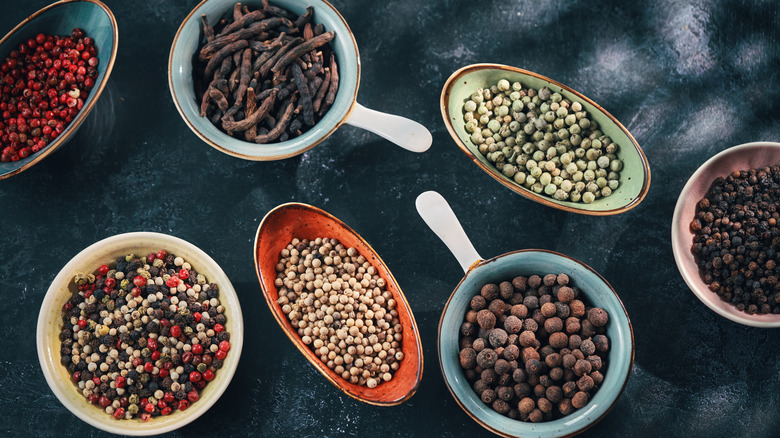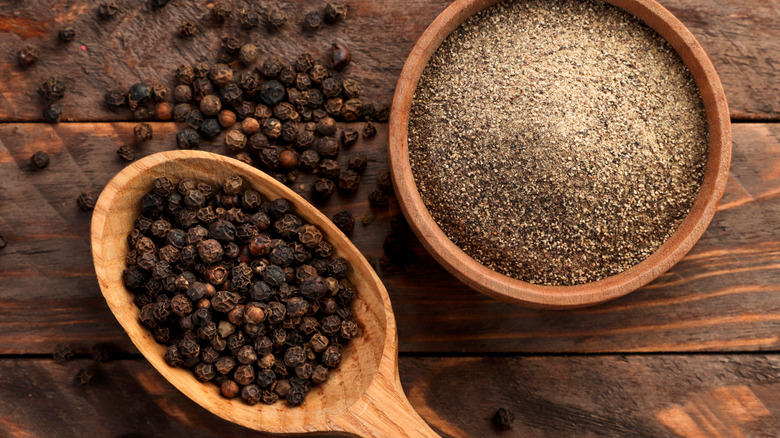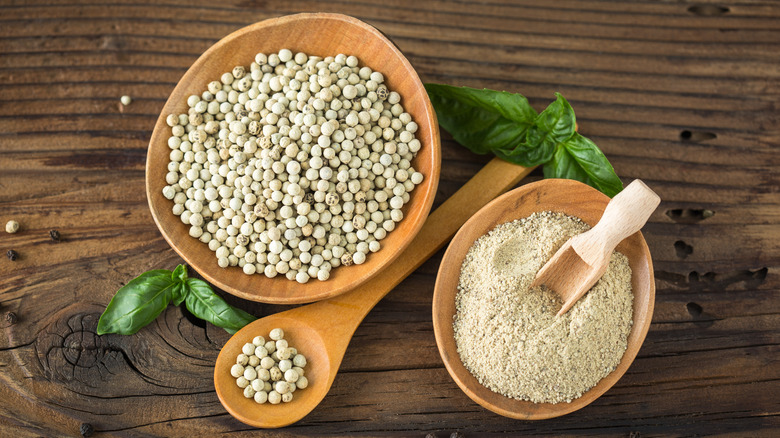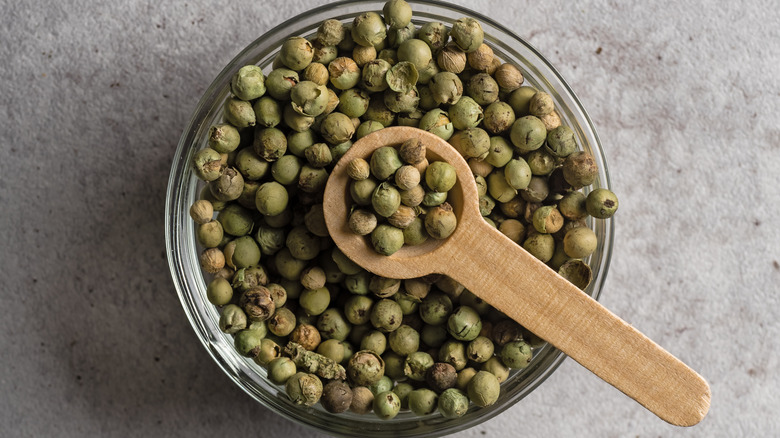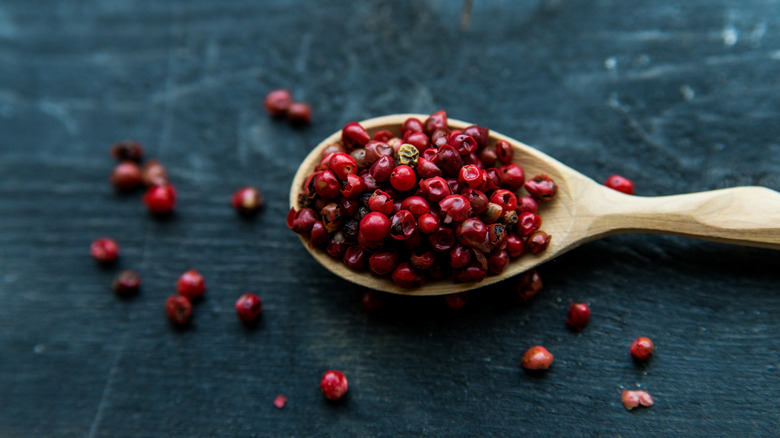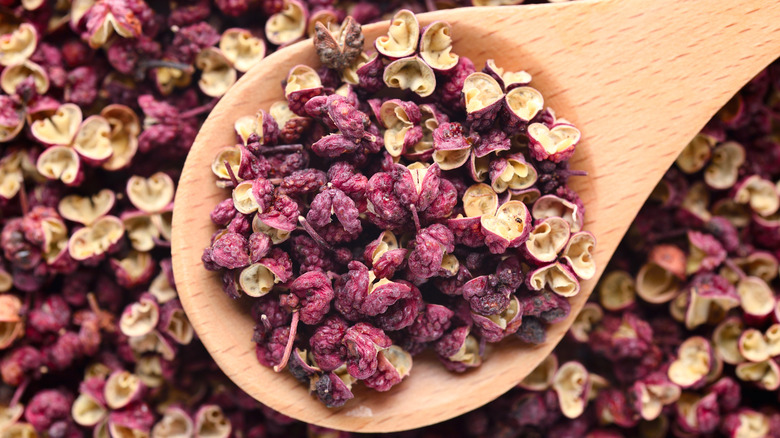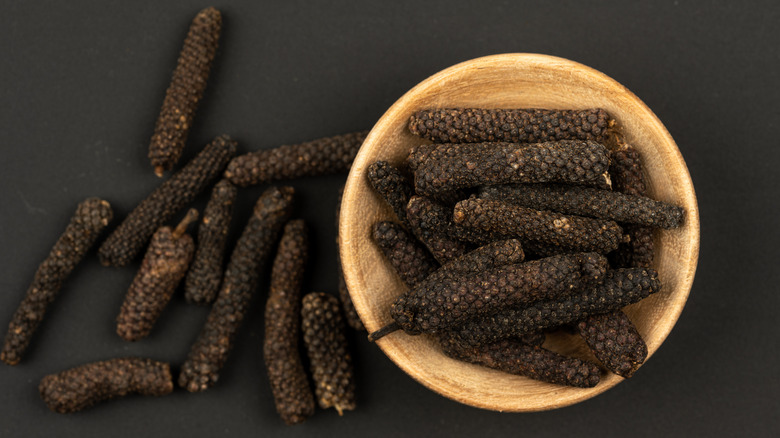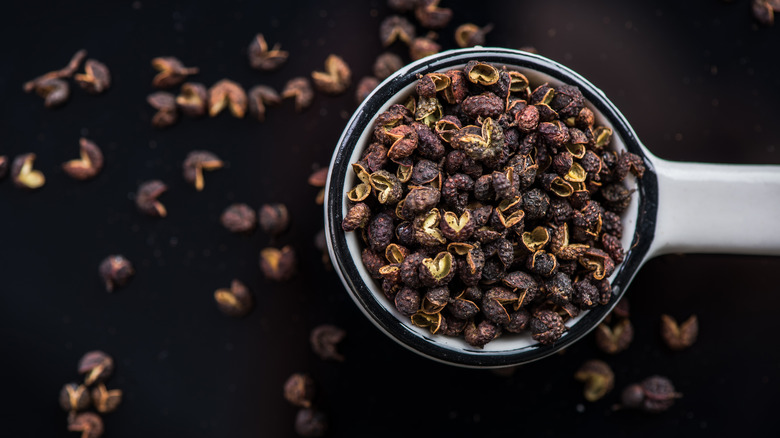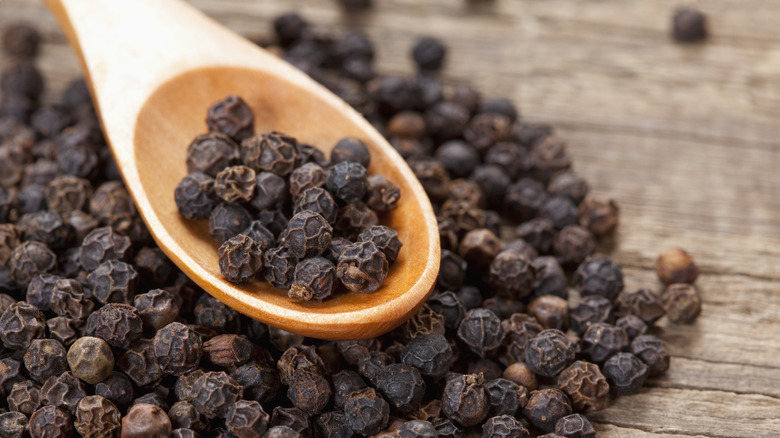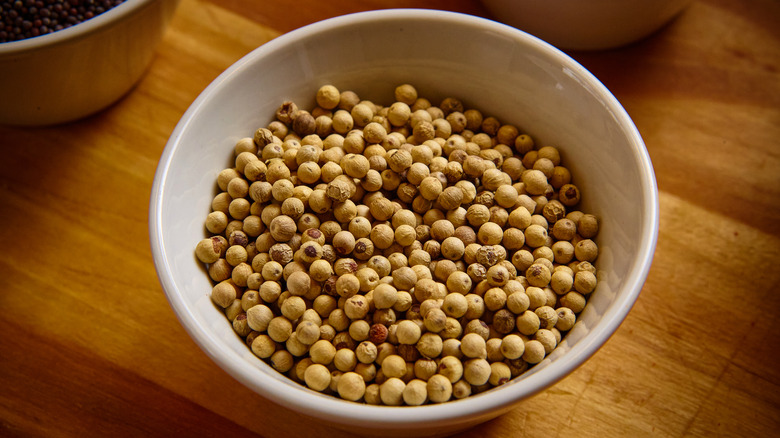9 Types Of Peppercorns And How To Use Them
Largely recognized as the most traded spice in the world, black pepper is used alongside salt in almost every type of cuisine. In fact, pepper is probably used in practically every dish you consume, whether homemade or from a restaurant. However, pepper's versatility doesn't end with black peppercorns. From pink to white to green to long, peppercorns come in several formats. There are even unusual peppercorns that produce a tingly sensation.
You've probably seen white pepper and mixed peppercorns in your neighborhood grocery store, but what about other varieties? Can you buy them separately, and if so, where? Are the different colors of peppercorns really all that different? Is it acceptable to use black pepper when a recipe calls for another kind? All these questions and more will be answered coming up. Keep reading to learn about the different types of peppercorns, what they taste like, and how they are used so you can take your knowledge of cuisine, spices, and home cooking to the next level.
Black peppercorns
The most popular type of peppercorn, the black peppercorn, is considered an essential spice by professional and home chefs alike. Most black pepper comes from Vietnam and has a vibrant flavor. Black pepper is so common you likely put it in most of your food and may even use more than a recipe calls for. Either way, the versatility of black pepper makes it the ideal complement to virtually any type of cuisine and nearly any dish.
Black peppercorns come in many varieties, but they all grow on a flowering vine, Piper Nigrum. Actually, you may be surprised to learn that most peppercorns start this way. The key to developing distinct color and flavor variations lies in when they are harvested and how they are processed. Black peppercorns are picked before they ripen, just like green peppercorns. Then, they are promptly dried, allowing their flavor to build and intensify. Thanks to the drying process, the green peppercorns become black and wrinkled, like you see them in the store. The final product is mildly spicy, often has slight hints of tobacco, and, at the risk of sounding redundant, has a peppery nose and taste.
Thanks to its popularity and widespread use, black peppercorns can be purchased in any grocery store. They are also easy to find online and are typically the least expensive variety of peppercorns. While you can also buy ground black pepper, chefs recommend purchasing it whole because the flavor is most intense when freshly cracked.
White peppercorns
White pepper tastes similar to black pepper, but it is a bit milder and has a less pungent smell. Oftentimes, white pepper is also hotter. Its flavor is considered to be somewhat grassy, musty, and fermented. Hints of ginger and floral elements can also be detected.
White pepper and black pepper come from the same plant and the same berry, Piper Nigrum. The difference has to do with the way it is harvested and processed. Unlike black peppercorns, white peppercorns are not harvested until they reach peak ripeness. Mature berries are picked and soaked to initiate fermentation. Then, they are washed and dried. During the process, the skins come off the peppercorns, leading to their white color and a less aromatic finished product.
White pepper can be used interchangeably with black pepper in small amounts. Just keep in mind it will be hotter. White pepper starts to lose its flavor once ground, so buy whole white peppercorns whenever possible to ensure maximum flavor potential. White pepper is great for light-colored sauces and dishes, like, béchamel, Alfredo, or mashed potatoes, because it blends without changing the color. Aside from using white pepper aesthetically, it is used in many Vietnamese and Cantonese recipes, like hot and sour soup.
Green peppercorns
In addition to white peppercorns, green peppercorns are derived from the same plant and berry as black peppercorns. However, they come from the opposite end of the spectrum. Instead of being harvested when ripe, they are picked when soft and under-ripe. Gathering the peppercorns before they mature leads to a milder taste, a softer texture, and, of course, their green color. Once picked, green peppercorns are generally preserved in brine but can also be found fresh, dried, and freeze-dried.
Compared to black pepper, green pepper has a fresher, grassier, somewhat earthy taste. When brined, green peppercorns may even be a bit sour, tangy, or bitter. Green pepper is also more subtle and less spicy than other types of pepper. Their light flavor makes them perfect for stews, marinades, salad dressings, and sauces. You're most likely to find green pepper in Indian and Thai recipes, which isn't surprising since they originally came from Southeast Asia. Green peppercorn sauce also goes wonderfully with steak. The best place to buy green peppercorns is from an Asian grocery store or an online retailer.
Green peppercorns provide several health benefits, including improved digestive health, resulting in an increased rate of digestion and a reduction of gas. Green peppercorns are rich in fiber and vitamins K and C, which are antioxidants. While this all sounds great, excessive green pepper consumption can lead to gastrointestinal irritation, so keep that in mind.
Pink peppercorns
Pink peppercorns are the first peppercorns on our list to come from a different plant. These brightly colored balls are the dried berries of Peruvian and Brazilian pepper trees. While not technically peppercorns, they are called peppercorns because they resemble them in shape and have a peppery flavor. Pink peppercorns are more closely related to cashews, mangoes, and even poison ivy than the Piper Nigrum tree from which other peppercorns are derived. As a result, you may want to avoid pink peppercorns entirely if you are allergic to cashews or mangoes.
Compared to black pepper, pink peppercorns have noticeable fruity, floral, and slightly sweet elements. In fact, the essential oil of pink pepper is frequently used in perfumes and skin care products due to its floral smell. Pink peppercorns' mild, zesty flavor makes them a fantastic addition to seafood dishes, poultry recipes, butter-based sauces, and even baked goods like shortbread. Its vibrant color also makes it an eye-catching garnish for salads and other plates.
Specialty grocery stores like Whole Foods Market and online spice purveyors are the best ways to purchase pink peppercorns by themselves. However, you will likely find them in mixed peppercorn blends at a regular grocery store. When cooking with pink peppercorns, they can be crushed or toasted to enhance flavor. They can also be ground but are too soft to be crushed alone, so make sure to mix them with other colors when going this route.
Szechuan peppercorns
Szechuan, or Sichuan peppercorns are technically dried seed husks, not peppercorns. They come from a citrus tree found in the Sichuan province, making them part of the citrus family. While Szechuan peppercorns come in both red and green varieties, you'll most likely only encounter the red one in the United States.
When eating Szechuan peppercorns, you're probably notice their heat first. Then, a tingly feeling follows, giving it unique properties and flavor implications. According to the Hong Kong University of Science and Technology, the tingly effect is caused by sanshoamide, a nerve-stimulating compound. When you consume sanshoamide, it makes your lips and tongue experience a numbing sensation. While not super spicy, the feeling Szechuan peppercorns cause can make you think they are.
Aside from the distinct sensory effect, Szechuan peppercorns have a floral, citrusy, and piney flavor that helps to balance out heat in dishes. They are most commonly used in Asian dishes like Szechuan noodles, mapo tofu, and various stir-fried meats and vegetables, but they can be used to spice up just about anything you want. In general, you'll want to crush them before using them. You can also slightly toast them to bring out a more complex flavor and smell, but they may become bitter if overcooked. While they haven't always been easy to find in stores, they are becoming more common every day. Even so, the best place to find Szechuan peppers is at an Asian market or online.
Long peppercorns
Closely related to black pepper, long peppercorns come from a flowering vine in the same family as Piper Nigrum but native to India. They are the spikey part of a large flower and have an oblong conical shape with tightly clustered peppercorns that make a notched texture. The cones are harvested, sun-dried, and used whole or crushed. Their taste closely resembles black pepper but is more complex and less spicy. Similar to Szechuan peppercorns, they tend to have a slightly citrusy flavor.
Used for centuries in Indian, African, Indonesian, and Mediterranean cuisine, the long pepper is not as common as it once was, especially outside India. Its fall from prominence is largely because it is hard to grow outside India and the wide-scale availability of black pepper. However, you'll still find it used in Indian, North African, and other regional Asian cuisines. When made traditionally, spicy rasam soup, nihari stew, and lentil curries all use long peppercorns. If you want to experiment with long pepper at home, it pairs wonderfully with barbecued meats.
Timut peppercorns
A rare type of black peppercorn, Timut peppercorns are native to Nepal and the surrounding regions; they even grow wild at higher altitudes. Instead of coming from the Piper Nigrum family, it is sourced from a tree in the prickly ash family. Even so, they still taste and look similar to regular peppercorns.
Timut peppercorns have a unique fruity flavor with strong notes of yuzu, lime, and grapefruit, plus a zesty aftertaste, making them unlike any spice you've had before. They also produce a noticeable tingling sensation similar to Szechuan peppercorns, but stronger. Timut peppercorns are commonly used in masala, chutney, and tea. Their citrus taste also makes them perfect for seafood, vegetable, poultry, and meat dishes. Thanks to their lack of heat, you can use them in almost any recipe you want. Feel free to experiment and use them in any food that could benefit from a bright, citrus flavor. You can also mix them into non-alcoholic drinks and cocktails.
You probably won't find it on the shelf at your local grocery store. Instead, online spice retailers are going to be your best bet.
Telicherry peppercorns
Tellicherry peppercorns, also called Thalassery peppercorns, are India's finest variety of black pepper. They tend to be less spicy than typical black peppercorns and have a much more complex, woodsy taste. Their flavor has elements of citrus, pine, fruit, and herbs, resulting in an intense, pleasing aroma.
Authentic Telicherry peppercorns are grown in Kerala, India, the state surrounding the historic port city of Thalassery. However, not all peppercorns grown in the region reach Tellicherry status. Only the biggest, most mature berries earn this high-grade ranking. To grow more prominent, Telicherry berries are left to ripen on the vine for longer, allowing them to benefit from extra nutrients, which leads to their more intricate flavor profile.
You can use Telicherry peppercorns the same way you use regular black peppercorns. At first, you may want to use slightly less than usual so you don't go overboard, at least until you get the hang of the increased flavor. To purchase Telicherry peppercorns, you'll want to go online. Just beware: Their prized status makes them more expensive than other kinds of peppercorns. In addition, make sure you use a trusted vendor because some purveyors have been known to falsely label their peppercorns as Telicherry to increase value.
Muntok peppercorns
Cultivated on the Indonesian island of Bangkla, Muntok peppercorns are a rare type of white peppercorn. Like other white peppercorns, this high-quality Indonesian pepper is picked at peak freshness and soaked or put under a stream of running water until the black husk breaks free, leaving the white center behind. The kernels are then dried before they are ready for consumption.
Muntok peppercorns have a rich, somewhat winey flavor with a spicy finish. Their earthy taste is phenomenal in soups, grilled meats, sautéed vegetables, light-colored sauces, and poultry. You can also blend them with a few black peppercorns to get a more complex flavor profile suitable for nearly every type of cuisine. Considering how rare Muntok peppercorns are, online spice purveyors are the best place to buy them. Don't worry, though; they aren't much more expensive than typical white peppercorns, so you shouldn't have to pay a premium price to try them out.
